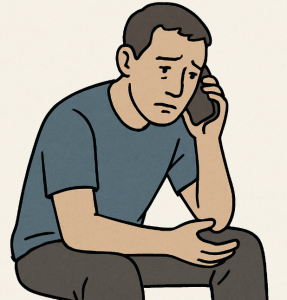
Why Smoking Gestures May Be Harder to Quit Than Nicotine
Here’s a personal anecdote.
I gave up smoking in 2008, coming down from a pack a day. I gave up drinking in 2017, coming down from similar amounts.
I don’t want a drink. I still sometimes crave a cigarette
It’s not uncommon. Picture a smoker stepping outside during a stressful day. Before the first puff, there’s already relief—the familiar click of the lighter, the ritual inhale, the rhythm of the breath. According to new research from the University of Verona, these gestures aren’t just habits—they may be ritualized coping mechanisms that soothe anxiety, independent of nicotine.
In a study published in Frontiers in Public Health (October 2025), researchers led by Lorenzo Zamboni explored how smoking-related gestures—like holding, lighting, and lifting a cigarette—interact with anxiety and nicotine dependence among people seeking help to quit. Their findings point to a blind spot in many smoking-cessation programs: focusing only on chemical addiction while overlooking the behavioral rituals that keep people hooked.
Beyond Nicotine: The Power of the Habit Loop
The study draws on what psychologists call the Habit Loop Model, which describes how behaviors become automatic:
- Cue – A trigger such as stress or anxiety.
- Routine – The action that follows: lighting up, inhaling, or simply fiddling with the cigarette.
- Reward – The calming effect that reinforces the cycle—even if it has little to do with nicotine.
For anxious smokers, the soothing comes not from the smoke, but from the predictability and rhythm of the gesture itself. Over time, this repetitive motor behavior may activate the brain’s dopamine pathways in much the same way as a chemical reward does.
“Smoking gestures can act as self-soothing rituals,” Zamboni explains. “They provide sensory feedback and predictability, helping people regulate emotions—even when nicotine levels are low.”
Inside the Study
The research team recruited 81 treatment-seeking smokers at a hospital addiction unit in Verona, Italy. Each participant completed:
- The Fagerström Test for Nicotine Dependence (FTND) – a standard tool measuring physical addiction;
- The Beck Anxiety Inventory (BAI) – assessing anxiety symptoms; and
- A single 7-point question rating how important the act of smoking itself (the gestures) felt to them.
Statistical analysis revealed a clear pattern:
🔹 Higher anxiety scores were linked with greater importance placed on smoking gestures (ρ = 0.254, p = 0.0224).
In contrast, anxiety levels were not significantly related to nicotine dependence scores. This means that some smokers who aren’t physically dependent on nicotine may still struggle to quit because they rely on the ritual for emotional regulation.
What This Means in Practice
Public health practitioners, clinicians, and program designers can draw three major takeaways from this research:
- Don’t overlook the behavioral dimension of smoking.
Quitting strategies should address both chemical and sensorimotor dependence—the way people physically and emotionally engage with cigarettes. - Integrate anxiety-reduction tools into cessation programs.
Cognitive-behavioral therapy (CBT), mindfulness-based stress reduction, and brief relaxation training could help smokers manage the anxiety that triggers these gestures. - Consider transitional tools—but with caution.
Devices like e-cigarettes or non-nicotine inhalers may temporarily satisfy the need for the hand-to-mouth ritual while reducing exposure to toxins. But as Zamboni’s team warns, they must be part of a planned off-ramp to avoid substituting one dependency for another.
Why Gestures Matter
The study reframes smoking not just as a chemical addiction but as a multisensory behavioral ritual. Touch, motion, and routine can all reinforce the habit—especially when anxiety is high.
This might explain why some patients relapse after pharmacological treatments like nicotine patches or varenicline. These therapies address nicotine withdrawal but leave the behavioral “loop” intact. If lighting up has become a personal ritual of calm, removing nicotine alone doesn’t break the cycle.
From a neurological standpoint, the researchers point to brain areas such as the basal ganglia and amygdala, which link habit formation and emotional regulation. The repetitive gestures may trigger dopaminergic responses even without nicotine, meaning the brain still gets a small “reward” each time.
Barriers and Next Steps
The authors acknowledge this was a preliminary study, with a small sample limited to people already in treatment. The single-item measure of gesture importance also lacks the precision of a validated scale. But the team sees that as a call to action:
“There’s an urgent need for a standardized tool—perhaps a ‘Gestural Smoking Scale’—to measure how much these behaviors matter in addiction and recovery.”
Future research could explore whether specific therapies that disrupt or redirect these gestures—such as stress-ball exercises, breathing techniques, or hand-occupying routines—could improve quit rates among anxious smokers.
The Bigger Picture
Globally, smoking remains the leading preventable cause of premature death, claiming roughly 10 % of all annual deaths and costing over $1.4 trillion in health care and productivity losses. Yet even with decades of anti-tobacco campaigns, relapse rates remain high.
By shining light on the behavioral rituals behind smoking, this study adds a new dimension to tobacco control: addiction may be sustained not only by what’s in the cigarette, but by what the cigarette represents—a familiar rhythm for calming the mind.
What’s Next
This line of research opens new questions for public health and behavioral science:
- How can cessation programs integrate gesture-replacement strategies effectively?
- Should public health messaging acknowledge emotional regulation as a driver of tobacco use?
- Could wearable technologies help monitor or interrupt habitual gestures in real time?
As we deepen our understanding of tobacco dependence, one truth becomes clear: quitting smoking isn’t just about removing nicotine—it’s about replacing the rituals that comfort, calm, and control.



